Like the earlier trips mentioned above, this journey was intended to observe changes since my previous visit on 21st June 2014 when I travelled the whole of the Cumbrian Coast Line from Carnforth through to Carlisle. described in two posts (Part 1 and Part 2). Although I'd changed trains at Whitehaven in 2014, I made only a brief excursion out of the station because of the timing of a connecting service taking me further north.My report at the time commented "I decided to defer my exploration of Whitehaven to another trip". For the March 2019 trip, less time was available and the winter timetable was in operation with, I thought, fewer trains so I decided to simply visit and explore Whitehaven, only travelling on the northern part of the Cumbrian Coast Line between Whitehaven and Carlisle. I settled on the trains outlined below and successfully ordered tickets from the Virgin Trains website.
Getting there
These were the timings of the trains I decided to use:-
| Wolverhapton-Whitehaven | Arrive | Depart |
| Wolverhampton | 09:37 | |
| Carlisle | 12:00 | 12:08 |
| Whitehaven | 13:15 |
| Whitehaven-Wolverhapton | Arrive | Depart |
| Whitehaven | 14:38 | |
| Carlisle | 15:41 | 16:08 |
| Wolverhampton | 18:32 |
The first part of the trip involved a Virgin Trains 'Pendolino' from Wolverhampton to Carlisle (reporting number 9S47). The southern part of the route was fairly familiar to me although when my coach stopped just level with the '158' milepost (distance from Euston) on platform 11 at Crewe, I didn't recall noticing it before yet it had clearly stood there for some time.
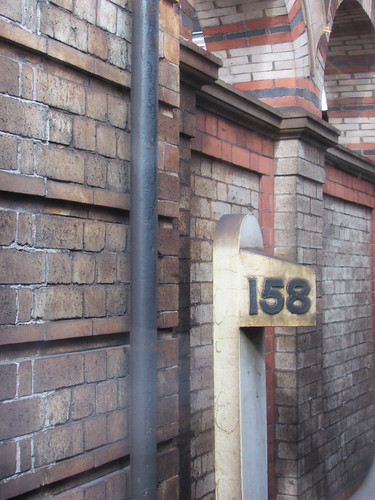
Crewe: Milepost and polychrome brickwork on platform 11.
At Lancaster, my coach stopped next to the British Transport Police office, the station's Defibrillator (in a rather rusty case) and the Blue Plaque commemorating Joseph Locke (1805-1860), Engineer of the Lancaster and Carlisle Railway which opened 15th December, 1846 (The line from Lancaster to Preston had opened a few years earlier, in 1840). A Policeman and Station Cleaner appeared to be enjoying a joke.

Lancaster platform 3 with policeman and cleaner.
Continuing north after our station stop, we were soon through Carnforth where the Cumbrian Coast Line diverged on our left and we headed into the fells with the gradients predominantly uphill. My train swept through the rather gloomy trainshed at Oxenholme where the single line to Windermere diverged to the left.
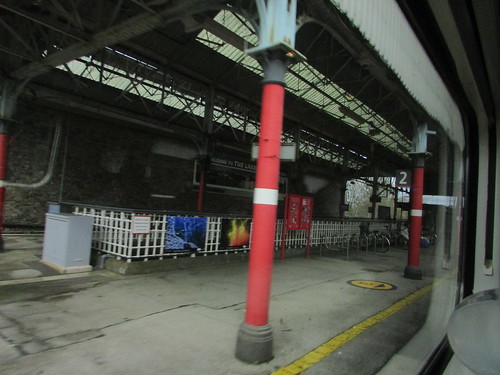
Oxenholme platform 2 looking towards the Windermere platform.
As we continued north, the gradient toughened to around 1 in 104. Kendal was laid out on our left then the climb continued until Grayrigg, where there are still goods loops on both Down and Up lines.

Kendal, viewed from West Coast Main Line.
Beyond Grayrigg, the route was easier and undulating until Tebay where, in steam days, most northbound trains stopped to pick up a banking engine (typically a 2-6-4T). The station, loco shed and signal box which once controlled the branch to to the east are all gone but a reversible loop and Engineer's sidings remain on the Down side.

Passing the Up and Down Goods Loop on the Down side at Tebay, with 3 Engineers sidings beyond.
Beyond Tebay, the 4 miles at 1 in 75 uphill to Shap Summit (quoted as 916 feet above sea level) presented serious problems to enginemen in steam days, even with a 'banker', because all the power to move the train depended upon the skill of the fireman in releasing the thermal energy stored in coal to generate steam. Today's drivers of electric trains can expect power to be available on demand from the Overhead Line Equipment, generated at some remote power station and our ascent appeared effortless.
Near the summit, on our left, is Shap Blue Quarry, operated by Cemex to supply aggregates. Beyond Shap Summit, the remaining 31 miles to Carlisle is downhill (apart from a couple of short adverse sections around Penrith). About one mile further on, we passed the huge processing plant of Tata Steel's Shapfell Limestone Quarries on the right.
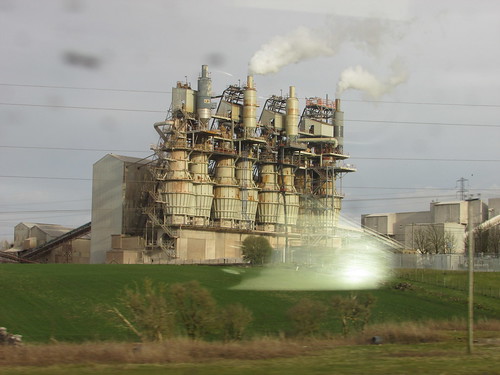
Shapfell Limestone Quarries, Hardendale, on Up side.
Another three miles took us past Hanson Aggregates Shap Quarry. Hanson are now part of the HeidelbergCement Group but I remember the quarry's pre-Hanson incarnation as 'Harrisons' which lent its name to the long-gone signal box on the main line there called Harrisons Siding. I actually visited the quarry once. In the post Visiting Steelworks I described my firm's involvement with Electronic Vibratory Feeders and the visit to the quarry was to help commission equipment our Client had installed there.
We sped under the modern bridge carrying the M6 motorwayover us then, about 5 miles further on, we crossed over the M6.

Penrith: Crossing M6 just south of station: view on Down side.
Deceleration indicated that the driver was preparing for our stop at Penrith.

Penrith: Down Main platform
After restarting from the station stop, we soon spooled off the remaining 18 downhill miles to Carlisle. Like Crewe, the major junction at Carlisle had interested me as a child, but it was too remote for me to visit. Just as Crewe had its complex of Independent lines for goods traffic, so Carlisle developed a network of avoiding lines for freight trains. As we approached Citadel Station, with the Maryport line converging from the left, both routes crossed over the once-important Upperby and Newcastle Goods Lines.

Carlisle: View on Down side entering Carlisle from Penrith. Left: Goods Lines from Upperby, Right: Newcastle Goods Lines. The bridge carries the Maryport and Carlisle Lines.
Finally, we rolled past Carlisle Power Signal Box which, like Warrington and Preston Power Boxes passed earlier in the journey, a Westinghouse-supplied installation with 'NX' control panel.
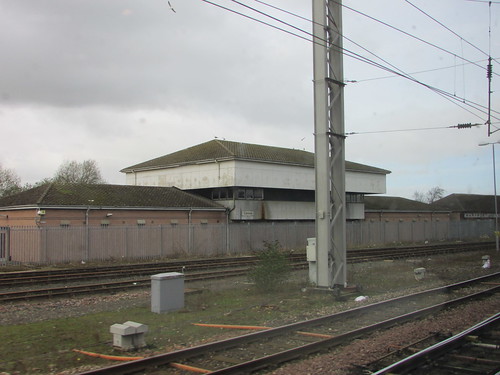
Carlisle Power Signal Box.

Carlisle: South end of Bay platform 2, viewed from Down train arriving at platform 3.
Right time, my train gently came to a stand in Carlisle platform 3 and the Class 156 Diesel Multiple Unit which would take me to Whitehaven (reporting number 2C52) was already in the adjacent bay platform 2. Although the weather was rather dull, I took a few pictures before boarding my train, including the one below.

Carlisle platform 3, looking south, showing rear of my train from Wolverhampton.
The Barrow train set off on-time at 12:08 and curved away from the West Coast Main Line I'd just arrived on, crossing the Upperby and Newcastle Goods Lines. We passed the cleared site which was once Currock Wagon Shops, with just rows of dug-up track formation and a few capstans (which moved wagons with ropes) evidencing the site's former use.

View from 2C52 leaving on Maryport and Carlisle Line, showing site of former Currock Wagon Shops.
After around 3 miles, we passed Dalston station but, unlike most services, we were not booked to stop and hurried past Dalston Oil Terminal into a stretch of pleasant farmland, punctuated by periodic user-worked level crossings. After around 7 miles we stopped at Wigton, after passing the first semaphore distant signal I'd seen that day.
Wigton was host to a large manufacturing plant but, at the time, I couldn't work out what was made there. Afterwards, I found out that Innovia Films is a major manufacturer of packaging films, particularly 'BOPP' which is Biaxially Orientated Poly Propylene (who knew?).
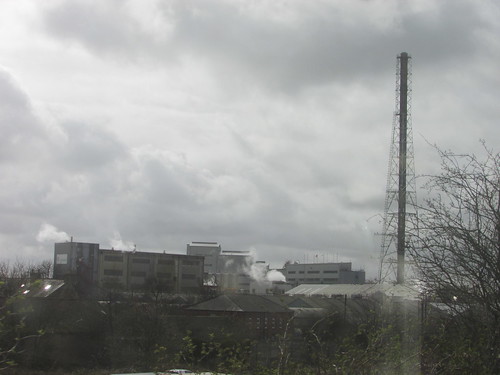
Innovia Films manufacturing facility, Wigton.
Wigton signal box, a manually-operated B.R. Standard pattern, is still in use presumably as a 'Fringe Box' to Carlisle and retaining a number of semaphore signals. The rest of my journey to Whitehaven would be controlled by manual signal boxes and mainly semaphore signals.
The next station was Aspatria where, like Dalton, we were not booked to stop. I was surprised to see a large Sealy plant. I knew the name but couldn't place the product at the time so it was only afterwards I found out that Sealy claim they're the "biggest bed brand in the world" with the first cotton-filled matresses being made by Daniel Haynes at a business in Sealy, Texas, over 100 years ago. Next to Sealy, we passed another large plant for 'The Lake District Creamery', operated by First Milk, a wholly British farmer-owned dairy co-operative.
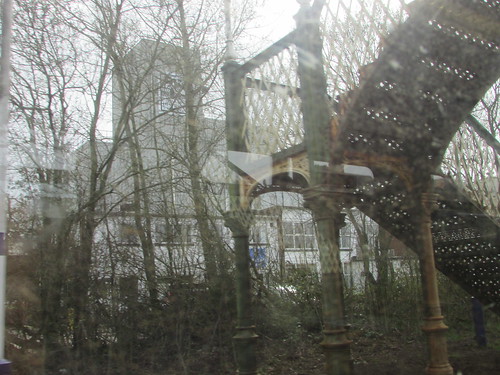
Aspatria: We didn't stop but I just glimpsed the large Sealy plant through the trees.
Maryport retained its elderly signal box in a modernised form with 2-aspect colour light signals and 'Clamp-Lock' point operation. It also supervised a full barrier crossing about a quarter of a mile beyond the station using Closed Circuit Television.

Maryport Station Signal Box.
Another couple of miles took us to Flimby station, right next to the sea. It retained what appears to be the original footbridge and two platforms and has one of the squalid, modern 'bus shelters' but nothing else, so I was unsurprised that we didn't stop here, either. For other trains, Flimby is a 'request stop'. I understand that Sea Defence Works have been necessary on the line from Flimby to Workington.
Before we reached Workington, we passed the huge mill, surrounded by large wind generators, operated by Iggesund Paperboard which makes 'Incada' folding box board (FBB).

Workington: Iggesund Paperboard mills.
After crossing the broad River Derwent we came to a stand in Workington's Up Platform, where I admired, once again, the station buildings while the train crew was changed.

Workington station Up Platform buildings.
We left Workington, with its derelict sidings on our left and Workington Main No.2 signal box on our right. I noticed that the former steelworks site on our right is spawning new housing estates by Persimmon Homes.
After a couple of miles we passed Harrington station, once again without troubling to stop, although most trains during the day do pause at this rather attractive village. I gather that Sea Defence Work has also been necessary both north and south of Harrington.

Harrington viewed from Harrington Viaduct Up side (Whitehaven railways).
Between Harrington and just north of Whitehaven, the line runs on a 'shelf' between the sea (to the west) and the cliffs (to the east). This line was originally double track throughout but a combination of coastal erosion and crumbling cliffs has required significant sea defence work combined with stabilisation of the cliffs. In places the cliffs had been 'pinned' with steel rods or were covered by heavy gauge netting to minimise the effect of rock falls. The base of the cliff had been protected by Gabions (steel cages filled with stones or rock) or pre-cast concrete blocks. Despite this work, in the worst affected section, the double track singled for just over three quarters of a mile to squeeze its way through. The line then became double again through Parton station to Whitehaven. Remote control of this signalling complication was provided from the elderly but modernised signal box at Whitehaven, Bransty Junction, using 2-aspect colour light signals and 'Clamp-Lock' point operation.

Civil works near Parton, landward side, showing steel rods, netting and gabions. Note paraglider flying above the cliffs (Whitehaven railways).
We were not booked to stop at Parton either, although most other services regard it as a 'request stop' so we continued into Whitehaven station, stopping in the single through platform.

Parton village, just south of station, viewed from Up side.
My train was booked to arrive at 13:15 and leave at 13:17, giving the driver just two minutes to leave his cab, walk to the 2-aspect colour light signal on the platform, telephone the signalman to ask for the single line token to St. Bees, open the Token Cupboard, extract the token from the electric token machine, lock the Token Cupboard, check that the signalman had 'cleared' the signal, replace the telephone handset and return to his driving cab to await the Guard's 'Right Away'.
 Whitehaven railways: Driver of 2C52 obtaining token for single line to St. Bees.
Whitehaven railways: Driver of 2C52 obtaining token for single line to St. Bees.

Whitehaven railways: Class 156 forming 2C52 to Barrow ready to leave Bransty.
I watched until the train had disappeared into the inky blackness of the 1,283 yard single line tunnel leading to Whitehaven's other station, Corkickle. Now bathed in bright sunshine, I left the station and walked down the hill for my brief exploration of Whitehaven. I'll tell you more when I can.
Related Posts on other Websites
Cumbrian Coast line (Wikipedia).
Tata Steel (Shapfell Limeworks).
Innovia Films.
Sealy.
First Milk.
Iggesund.
Related Posts on this Website
The following posts describe my previous visit to the Cumbrian Coast in 2014:-
Furness and the Cumbrian Coast (Part 1)
Furness and the Cumbrian Coast (Part 2)
My pictures
Where necessary, clicking on an image above will display an 'uncropped' view or, alternately, pictures may be selected, viewed or downloaded, in various sizes, from the albums below:-
In making my (often quite poor) pictures available on the internet, I have divided them into various albums each covering a roughly-defined geographical area. Within each album, photographs are normally arranged by date taken. Thus, by searching through the appropriate album, you can find changes through time. So, my trip to Whitehaven added pictures to a number of albums as we moved through various areas.
The journey:
West Midland Railways (Wolverhampton).
Stafford Area rail.
Crewe Area rail.
Liverpool area rail (Winsford-Weaver Jn).
Warrington Area rail.
Wigan's Railways.
Railways around Preston.
Lancaster area rail.
Carnforth railways.
WCML through Cumbria.
Carlisle's Railways.
Whitehaven railways.
Workington Main station (and surrounds).
The destination and non-railway pictures:
Cumbrian Coast Scenes.
Whitehaven.
